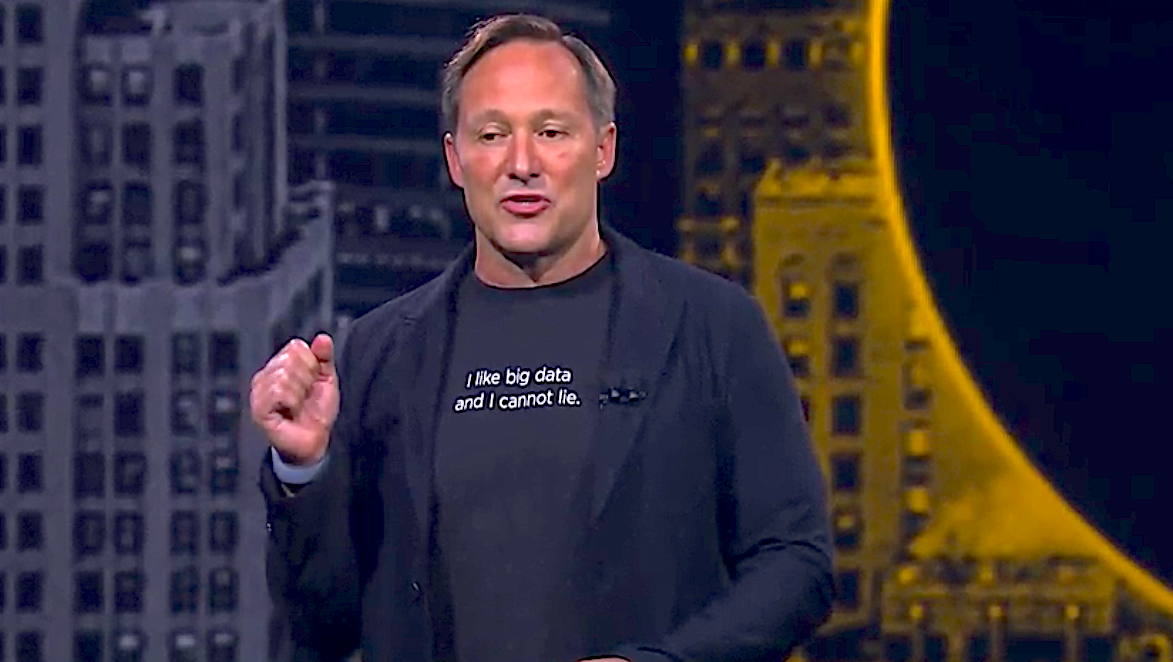 BIG DATA
BIG DATA
 BIG DATA
BIG DATA
 BIG DATA
BIG DATA
Splunk Inc. kicked off its .conf 2018 conference today with the introduction of numerous new features, plus a few upcoming ones, that aim to bring analytics projects into the age of artificial intelligence and software containers.
The capabilities are rolling out for the company’s flagship machine data processing platform. They’ll become available in both the on-premises Splunk Enterprise and the managed version, Splunk Cloud.
In his keynote address at the .conf conference in Orlando, Florida, Splunk Chief Executive Doug Merritt (pictured) said businesses can’t just keep track of enterprise resource planning data inside their data centers anymore. “If we really want to be successful, we’ve got to tap into this sea of data around the world, outside of our walls,” he said.
Splunk MLTK, an application that the company has built atop the platform to address AI use cases, now works with two key open-source technologies from the machine learning ecosystem. The first is the popular TensorFlow engine for building AI models while the other a library called MLib. The latter software is part of Apache Spark, a widely used data processing engine geared toward large-scale analytics that Splunk customers can now harness in their AI projects.
The third technology that the company ticked off its checklist today is the Docker container engine. Containers provide the ability to deploy software in a lightweight, infrastructure-agnostic form that can simplify certain operational tasks such patching. Splunk will now start officially providing support to customers that choose to run its platform on Docker, which should make containers a much more feasible deployment option for risk-averse large enterprises.
“Our product vision is aimed at opening the aperture to bring Splunk everywhere, for everyone, and to help our customers pattern match everything with artificial intelligence and machine learning infused across the entire product portfolio,” Splunk Chief Technology Officer Tim Tully said in a statement.
Splunk is pairing the expanded AI and container support with an array of new features designed to give companies more flexibility in how they manage their analytics environments. The main focus is on hardware resource management.
The company also pulled back the curtains on SmartStore, a feature that analyzes how users interact with the data in a deployment and provides advice on how to store it. SmartStore can, for instance, determine if there’s infrequently-accessed data lying around that could be moved to lower-cost storage infrastructure. The tool also detects information being used for real-time projects that require faster storage hardware.
SmartStore is complemented by another optimization feature that in turn focuses on queries. Aptly named Workload Management, it lets companies customize how hardware resources are allocated to searches and alerts to ensure that high-priority analytics projects always run optimally.
The data professionals who drive those analytics projects are getting new features as well. Splunk has added a graphical interface that provides project-specific guidance on how to import data, a console for monitoring metric-based information and the ability to create metrics from logs. The latter feature makes it easier to extract and track specific data points such as server performance from the information-packed logs generated by modern technology infrastructure.
Splunk has plans to expand its platform’s analytics capabilities even further in the future. Alongside the update, the company previewed several upcoming features that are entering beta. Among them are an analytics engine for processing data in real time and a federated search function that will let users run a query across multiple Splunk deployments.
Dave Vellante and Stu Miniman, co-hosts of SiliconANGLE Media’s livestreaming studio theCUBE, provided an analysis of Merritt’s keynote, kicking off two days of coverage of the .conf conference:
(* Disclosure: Spunk is sponsoring coverage of .conf. Sponsors have no influence on editorial coverage on SiliconANGLE or theCUBE.)
Support our mission to keep content open and free by engaging with theCUBE community. Join theCUBE’s Alumni Trust Network, where technology leaders connect, share intelligence and create opportunities.
Founded by tech visionaries John Furrier and Dave Vellante, SiliconANGLE Media has built a dynamic ecosystem of industry-leading digital media brands that reach 15+ million elite tech professionals. Our new proprietary theCUBE AI Video Cloud is breaking ground in audience interaction, leveraging theCUBEai.com neural network to help technology companies make data-driven decisions and stay at the forefront of industry conversations.